
Ozothamnus is a genus of plants found in Australia, New Zealand and New Caledonia.

Calomeria is a plant genus in the family Asteraceae.

Ozothamnus ferrugineus, commonly known as tree everlasting, is a member of the genus Ozothamnus, of the Asteraceae family – one of the largest families of flowering plants in Australia. Native to the Australian states of New South Wales, Victoria, South Australia, and Tasmania, it forms an erect shrub or small tree between 2 and 3 metres in height.
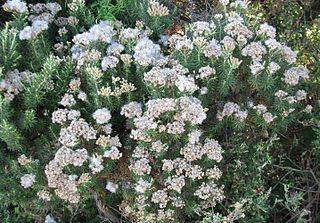
Ozothamnus turbinatus, the coast everlasting, is a shrub in the family Asteraceae, native to the states of New South Wales, Victoria, South Australia and Tasmania in Australia. It grows to between 1 and 2 metres in height.

Acanthocladium dockeri is a critically endangered species of the family Asteraceae that belongs to the monotypic genus Acanthocladium. It is commonly known as spiny everlasting or spiny daisy. It is native to Australia, and is found around the South Australian town of Laura.

Ozothamnus obcordatus, the grey everlasting, is a shrub in the family Asteraceae, native to the states of Queensland, New South Wales, Victoria and Tasmania in Australia.

Ozothamnus secundiflorus, the cascade everlasting, is an aromatic shrub species, endemic to Australia. It grows to between 0.5 and 2 metres in height. Leaves are 6 to 10 mm long and 1.5 to 4 mm wide. These are dark green with grey hairs on the upper surface, and white tomentose below. The white flower heads appear in dense clusters along one side of the stem between December and February in the species' native range.

Ozothamnus cupressoides is an aromatic shrub species, endemic to Australia. Common names include scaly everlasting, lattice everlasting or kerosene bush. It grows to between 0.5 and 1 metre in height and has white-tomentose branchlets. The scale-like leaves are 1 to 3 mm long and 0.5 to 1 mm wide. These are green on the upper surface, and white tomentose below. The flower heads appear in dense clusters in summer and autumn The species occurs in boggy sites and subalpine heathland in New South Wales and Victoria. It was first formally described in 2010 in the journal Muelleria.
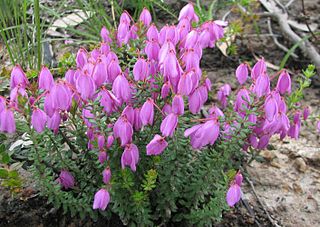
Tetratheca bauerifolia, commonly known as heath pink-bells, is a flowering plant in the family Elaeocarpaceae and is endemic to eastern Australia. It is a small compact shrub with pink-mauve flowers.

Coronidium scorpioides, commonly known as the button everlasting, is a perennial herbaceous shrub in the family Asteraceae found in Australia. Previously known as Helichrysum scorpioides, it was placed in the newly described genus Coronidium in 2008.
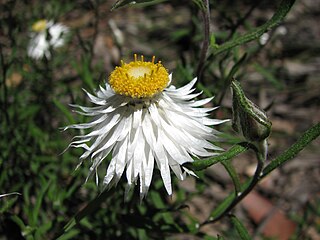
Helichrysum leucopsideum, commonly known as satin everlasting, is a perennial herb in the family Asteraceae. It is native to southern Australia. It produces terminal flower heads, mainly between spring and early summer. The white bracts spread out or become reflexed with age.

Pachymitus is a monotypic plant genus in the mustard family Brassicaceae. The sole species is Pachymitus cardaminoides, commonly known as sand cress, which is native to Australia. It occurs in the states of New South Wales, Victoria and South Australia.
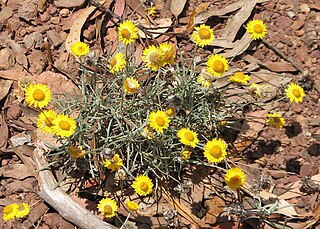
Leucochrysum albicans, commonly known as hoary sunray, is a species of plant in the family Asteraceae. It is endemic to Australia. It grows to 45 cm high and has grey-green woolly leaves that are between 2.5 and 10 cm long and 1 to 9 mm wide. The flowerheads appear between spring and summer. These have yellow centres surrounded by either white or yellow bracts.
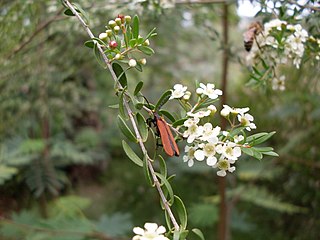
Sannantha pluriflora, commonly known as tall baeckea, is a flowering shrub or small tree species in the myrtle family, Myrtaceae. It is endemic to Australia. Plants grow to 4 metres high. White flowers appear in groups of three to seven between October and April in the species' native range. These have five rounded petals surrounding 8–15 stamens. The fruits are 2.5 to 3.5 mm in diameter.
Sannantha similis is a flowering shrub or small tree species in the myrtle family, Myrtaceae. It is endemic to Australia. Plants grow to 4 metres high. White flowers appear in groups of 3 to 7 between October and January in the species' native range. These have 5 rounded petals surrounding 8 to 15 stamens. The fruits are 2.5 to 3.5 mm in diameter.

Ozothamnus alpinus, commonly known as alpine everlasting, is a flowering plant in the family Asteraceae. It is endemic to alpine and subalpine areas in south-eastern continental Australia.

Ozothamnus rogersianus, commonly known as Nunniong everlasting, is a shrub in the family Asteraceae. It is endemic to Victoria, Australia.

Ozothamnus thyrsoideus, commonly known as sticky everlasting, is a flowering shrub, endemic to south-eastern Australia. It grows to between 0.5 and 2 metres in height. Leaves are 15 to 30 mm long and 1.5 to 2 mm wide. Flowerheads appear in terminal corymbs in the summer.
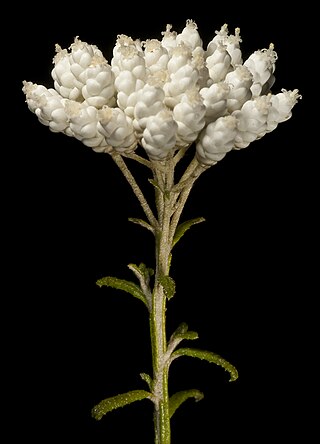
Ozothamnus occidentalis is a shrub in the family Asteraceae, native to Western Australia.
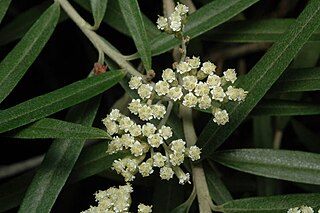
Ozothamnus stirlingii, commonly known as Ovens everlasting, is a flowering plant in the family Asteraceae and grows in New South Wales, Victoria and the Australian Capital Territory. It has globose-shaped white flower heads and sticky leaves.



















